How do I choose a bushcraft knife?
Bushcraft is one of the most popular outdoor activities today. Going out into the woods with a minimal amount of gear to become one with nature. Bushcraft is so much more than building a fire: it is a way of life. It is a philosophy. A way in which you can test your own ingenuity and work creatively. Bushcraft is impossible without a knife. However, there are so many bushcraft knives that it can become difficult to make the right choice. For that reason we would love to tell you more about how you choose a bushcraft knife.
What do you use a bushcraft knife for?
A bushcraft knife is a knife that was specifically designed for survival in the wilderness. It is often used by outdoorsman, scouts, the military and other adventurers who spend a lot of time in nature.
There are many different types of bushcraft knives, but they all have a sharp, strong tip and a sturdy blade. This makes them suitable for many different tasks. Within bushcrafting, you can distinguish between four different types of use for a bushcraft knife:
-
Cutting wood
The blade must be strong enough to chop through thick branches and cut through smaller branches. Also, the sharp edge should allow you to easily make feather sticks.
-
Preparing food
Bushcraft knives were specially designed for cutting meat and peeling fruit and vegetables. In the world of bushcraft, this usually involves preparing food you gathered yourself.
-
Survival tasks
Bushcraft knives are suitable for cutting and chopping wood, or for building a shelter. A bushcraft knife should also be able to take a beating during batoning, for example.
-
Building a fire
The bushcraft knife excels at making tinder and can be used with a firesteel. For these tasks, it's best if the blade is not coated and the back of the knife has a rough finish.
Now, we are the first to admit that you often perform several of these activities with the same knife anyway, and often, that works just fine. Nevertheless, there are certain details about the design of a knife that make it more suitable for some bushcraft activities than others.
Bushcraft: so much more than just survival
Bushcraft - a concept that is often misunderstood. Is it survival? Is it 'doing something in the woods'? Is it about building a fire? The answer is no, that is not bushcraft. It is so much more than that. We'll try to explain what bushcraft really is.
Bushcraft is a way of life. It is so much more than simply learning more about survival techniques. It is also about consciously choosing to stay outside and working together with nature. Bushcraft enthusiasts want to be a part of nature and want to learn all about how to do so properly. In addition to learning specific techniques, creativity is also key.
You need time to master the right knowledge and techniques. Bushcraft basically includes anything you need to live and survive in nature. For example, using a knife, building a fire, finding and preparing food, making a shelter. Things most people need to learn first.
Bushcraft will take you back to your roots, to the life once lived by your ancestors. Suddenly you will find yourself making your own cutlery, preparing your own meat over a fire you built yourself, and sleeping under a roof made from pine branches. According to many, this is true freedom.
Today, bushcraft courses are taught throughout the country. Handling your knife, spending the night in nature, preparing your own food, these are just a few of the skills you master during these courses. Within days, you will know for sure if the bushcraft lifestyle suits you.
Bushcraft knives: carbon vs stainless
Bushcraft knives come in many shapes and sizes. With many different philosophies regarding blade shapes and handle shapes. But there is one fundamental dividing line that cuts across all these different choices: carbon steel vs stainless steel. We explain how these two options relate to each other.
-
Bushcraft knives made from carbon steel
Carbon steel is steel that contains low levels of chromium and other alloying elements that are usually added to make steel stainless. It is therefore not stainless, and a knife made of this type of steel often changes colour after you use it for the first time. A big disadvantage, you might say. Nothing could be further from the truth: it offers opportunities. In general, carbon steel is tougher and easier to sharpen. Great when you are out in the field. And when this steel is enhanced with a coating, or a natural patina, the rust is not so bad. Examples of this steel are: 1095, 1075, 5160, O1, Böhler K720.
-
Bushcraft knives made from stainless steel
The name already gives it away: this steel is stainless. You don't need to worry about maintenance. Many of the modern types of stainless steel also retain their sharpness better than some types of carbon steel. However! There are disadvantages. Stainless does not mean completely rust-free. It can, and will, under certain circumstances, start to rust. In addition, nine out of ten times stainless steel is more difficult to sharpen than carbon steel, and in most cases it is less tough than carbon steel knives. Examples of stainless steel are: Böhler M390, Böhler N690, Sandvik 12C27, Elmax.
-
The hybrid: bushcraft knives made from tool steel
Between these two there is a great middle ground: tool steel. This is steel that contains a little more chromium than carbon steel, but not enough to be called stainless. The result is a type of steel that retains its sharpness well, is tough and often quite easy to sharpen. It is, however, not completely stainless. Examples of this type of steel are: CPM 3V, CPM CruWear, D2, Sleipner.
Buying guide
- Bushcraft knife for wood work
- Bushcraft knife for survival tasks
- Bushcraft knife for food prep
- Bushcraft pocket knives: folding knives
- Our top 5 bushcraft knives
Bushcraft knife for wood work
Wood work, also called woodcraft, is about processing wood to make your own shelter and tools. For example, carving your own spoons or setting up traps. It's important to choose a knife with an ergonomic handle with nice curves. A flat, high grip will start to hurt after prolonged use. It's also important that the edge is strong. A scandi grind is popular amongst wood workers for its sturdiness. In addition, a scandi grind can easily be sharpened.
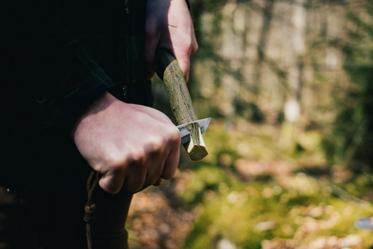
Bushcraft knife for survival tasks
Choosing the right bushcraft knife for survival tasks is suspiciously similar to choosing a regular old survival knife. We have already written something about that in our topic 'Survival knives: how do I choose the best one?' The most important thing is to choose a knife with a full-tang construction. This means that the steel of the blade runs all the way through the handle. This is a very strong construction that allows you to baton if needed.
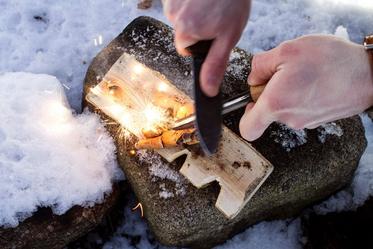
Bushcraft knife for food gathering and prep
For gathering food and performing kitchen tasks, a slightly thinner knife is more practical. It cuts more easily through different vegetables and such. It's also best to not pick the smallest knife you can find. Some additional blade length can come in handy when filleting a fish, for example. It's also smart to pick a knife that is easy to clean. Food scraps can get stuck behind nooks and crannies.

Bushcraft pocket knives: folding knives
Bushcraft is generally the domain of fixed knives. The reliability and strength of a fixed knife is much appreciated when your fingers are at stake. Nevertheless, there are also pocket knives that you can use for some wood working and food preparation. Absolutely not suitable for batoning! But fine for lighter wood work.
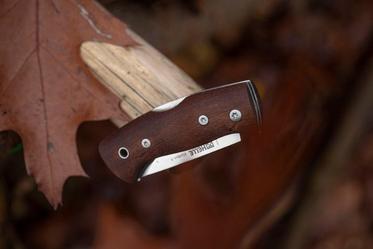
Our top 5 bushcraft knives
To end this topic, we are happy to share our top 5 bushcraft knives. Purely based on the knives that we at Knivesandtools prefer to use. Knives that we would take into the woods.
The difference between bushcraft knives and survival knives
As you might have read, these two knife types are very similar. This creates a lot of overlap and also a lot of confusion. To settle this issue once and for all, we wrote this in-depth article where we explain the differences in a more elaborate way. One thing that's good to know is that bushcraft knives are generally a bit lighter in weight and have a friendlier appearance.
Conclusion
Of course, we also know that there are as many preferences as there are people walking around. Therefore, these are definitely not the only bushcraft knives that are very good. This is just a selection of the models we find suitable for different applications and starting points. The most important thing about bushcraft remains that you just get out there, learn about nature and enjoy being outdoors.
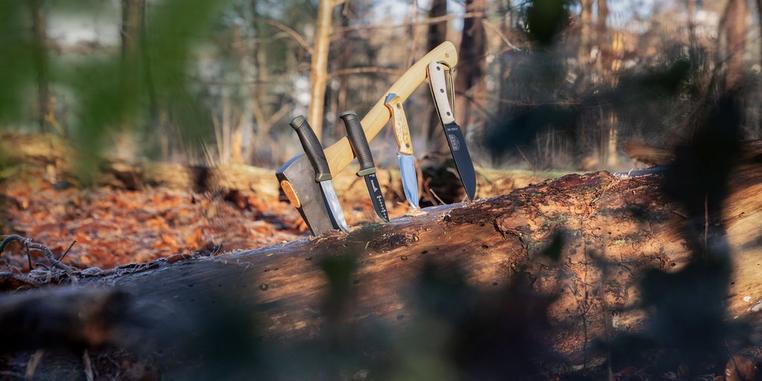

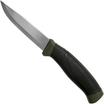









?%24center=center&%24poi=poi&%24product-image%24=&fmt=auto&h=500&poi=%7B%24this.metadata.pointOfInterest.x%7D%2C%7B%24this.metadata.pointOfInterest.y%7D%2C%7B%24this.metadata.pointOfInterest.w%7D%2C%7B%24this.metadata.pointOfInterest.h%7D&scaleFit=%7B%28%24this.metadata.pointOfInterest%29%3F%24poi%3A%24center%7D&sm=c&w=1208)

